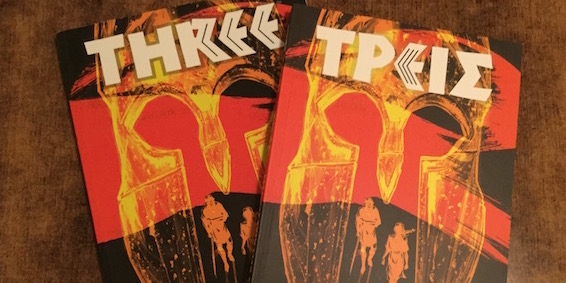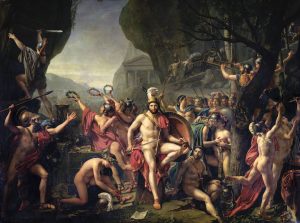
July 13, 2020, by Lynn Fotheringham
Thermopylae
(Διαβάστε στα Ελληνικά.) (Revised 10/08/20.)
CONTENT: ANCIENT GREEK SLAVERY, MILITARY VIOLENCE, SUICIDE (MISSION)
In the last post I talked about Arimnestos controlling his anger against Terpander, which was caused by Terpander telling him he ‘would never have fought with the 300.’ Here’s Terpander’s subsequent apology:

THREE, ch./issue 1, p.19 panel 5
Groups of 300 also feature in other areas of Spartan life, for example, as the standard number of the kings’ body-guard. The idea that the 300 at Thermopylae were all fathers, i.e. men whose families were not in danger of extinction, is a standard element of the tradition, usually understood as meaning that Thermopylae was a suicide mission.
This goes back to a passage from Herodotus 7, which is in fact rather confusing (and doesn’t explicitly mention suicide; Herodotus actually says Leonidas was expecting reinforcements). After listing the Greek troop-contingents at Thermopylae, including ‘Of the Spartans, three hundred men-at-arms’ (Σπαρτιητέων τε τριηκόσιοι ὁπλῖται), Herodotus continues:
204. Τούτοισι ἦσαν μέν νυν καὶ ἄλλοι στρατηγοὶ κατὰ πόλιας ἑκάστων, ὁ δὲ θωμαζόμενος μάλιστα καὶ παντὸς τοῦ στρατεύματος ἡγεόμενος Λακεδαιμόνιος ἦν Λεωνίδης ὁ Ἀναξανδρίδεω τοῦ Λέοντος … τοῦ Ὕλλου τοῦ Ἡρακλέος, κτησάμενος τὴν βασιληίην ἐν Σπάρτῃ ἐξ ἀπροσδοκήτου. 205. … ὃς τότε ἤιε ἐς Θερμοπύλας ἐπιλεξάμενος ἄνδρας τε τοὺς κατεστεῶτας τριηκοσίους καὶ τοῖσι ἐτύγχανον παῖδες ἐόντες· … |
204. All these had their generals, each city its own; but he that was most regarded and was leader of the whole army was Leonidas of Lacedaemon, whose descent was from Anaxandrides, Leon, … Hyllus, Heracles; who was king at Sparta, yet had not looked to be such. 205. … He now came to Thermopylae, with a picked force of the customary three hundred, and those that had sons; … |
- Text and translation A.D. Godley, Loeb Classical Library vol. 119, 1922.
The translator adds this comment on ‘and those who had sons’:
The regular number of the royal body-guard, the so-called ἱππεῖς [hippeis, ‘knights’]. No other translation of this sentence than what I have given is possible; but if “those that had sons” are added to the 300, this is inconsistent with the received tradition that there were only 300 Spartans at Thermopylae. There seems to be no explanation of the matter, except Dr. Macan’s theory that Herodotus made a mistake.
Godley’s reading of the sentence suggests that the total number of Spartans at Thermopylae may have been 300 hippeis plus an unknown number of additional men who had sons. But other translations of the sentence are possible.
-
The word Godley translates as ‘customary’, κατεστεῶτας, can also be translated as ‘stationed [in a position]’, ‘set in order’, ‘established’, ‘appointed’ or ‘set as guards’, among other things. Godley interprets the word as referring to the 300 men appointed (according to long-standing custom) as the kings’ bodyguard; these were young men and it is unlikely that they would all have already become fathers. But the word could have referred to something else about the men, e.g. to their status within Spartan society (they were ‘established’ men).
-
The word καὶ does mean ‘and’, but its use here doesn’t necessarily mean that the men who had sons were being ‘added’ to the 300; instead, we could translate the end of the sentence: ‘men who were established and who happened to have sons.’

Mythologising representations of Thermopylae include Jacque-Louis David’s “Léonidas aux Thermopyles” (1799-1814)
The fact that scholars argue about the meaning of this sentence provides a clear demonstration of the way that aspects of the Thermopylae tradition go back to very slender evidence. We’ll never know for certain what Herodotus meant, but it’s perfectly possible to imagine both that Thermopylae wasn’t originally a suicide mission – and that, 100 years later, people like Terpander and Arimnestos believed that it was!
For the possibility that most of what we are told about Thermopylae was made up as Spartan propaganda after an ignominious defeat, see this r/AskHistorians post by Dr. Roel Konijnendijk.
NOTE: I may refer to/quote comments on this post either in later blog-posts or in a research publication. More information about my audience-research, including a Privacy Notice and ways of getting hold of the book.
Extracts from Three © 2013 Kieron Gillen & Ryan Kelly. Used with permission.
Reproduction of David’s Léonidas aux Thermopyles from Wikimedia Commons.
No comments yet, fill out a comment to be the first

Leave a Reply